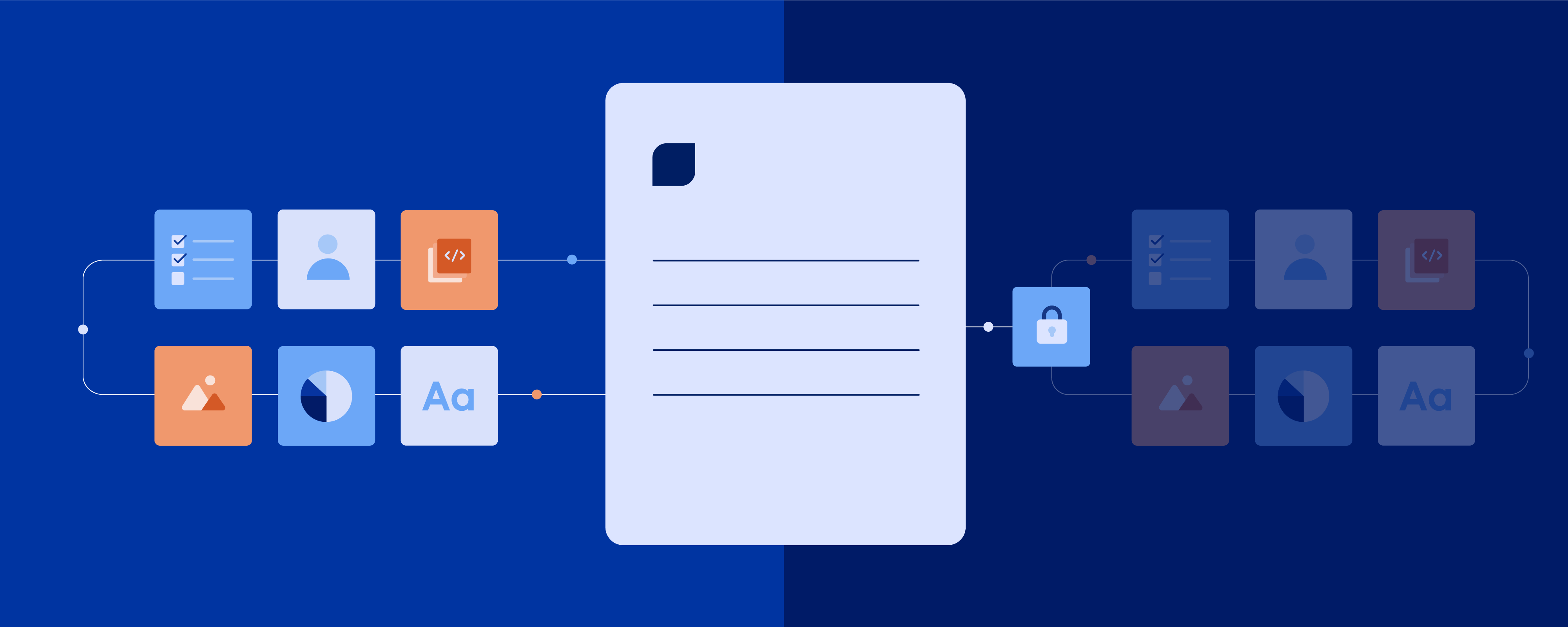Document management vs. document governance: an explainer

Companies today have a content problem.
Document management and document governance tools can help co organize the mounting piles of digital information – but what do these tools really do?
When tasked with creating a new piece of content — a PDF or other document, for example — 73% of workers said that they either save over an old version or start from scratch, pulling information from wherever is easiest.
This localized, siloed way of creating and managing documents is not only frustratingly inefficient — 62% of workers think their team wastes time recreating content that likely already exists in their organization — it also exposes organizations to quality and security concerns.
Within the financial sector, 70% of workers reported that their business had mistakenly shared a sensitive document with a party that was not authorized to view it.
That’s why so many organizations, now operating out of a digital HQ, are investing in document management systems, especially those which can help with document governance.
So before the jargon becomes too confusing, let’s break down each of these terms and explain how these tools can help teams get back to work (and stop reusing that one outdated report template).
What is document management?
Document management refers to a system for storing and organizing digital content such as word documents and PDFs, and is a sub-section of content management.
A robust document management system can help organizations and teams work more efficiently while also increasing security and regulatory compliance.
Most document management systems include features to assist with:
- Auditing and reporting
- Metadata and classification
- User levels and access management
- Version control
- Indexing, search and retrieval
- Template management
- Cloud storage
- Usage analytics
The Content is Everything report
2,000+ professionals on how rapid content growth is creating new risks
What is document governance?
Document governance is a related sub-speciality of document management, focusing primarily on security, user access and authentication, and ensuring there are proper audit trails for compliance and reporting purposes.
Document governance is a related sub-speciality of document management, focusing primarily on security, user access and authentication, and ensuring there are proper audit trails for compliance and reporting purposes.
What is document metadata?
Metadata is the information that allows document management and document governance systems to operate. It is, in essence, the content behind the content that describes each document and how it can be used.
Metadata can be used to describe:
- Who created, edited, or exported the document
- Titles, categories, or keywords
- When the document was created or last edited
- Who has access to view or edit the document
- A document’s classification status
Metadata provides the information that allows document management and governance tools to organize, filter, search, and report on their document libraries.
What are the benefits of document management?
Work smarter with automation
Discover new ways to save time and reduce errors with document automation. See how teams use smart tools to work faster.
Find documents more efficiently
Through the use of metadata, document management tools can search more effectively, helping employees find what they’re looking for faster and reducing duplication of effort.
Today, 69% of employees admit to using Google to find company assets, making it likely they will find offbrand, outdated, or incorrect information — or not find what they are looking for at all.
A proper document management system provides a single source of truth for all employees, integrated seamlessly into their document-building tools.
Increase security and compliance
Document governance, by applying and maintaining categories around document sensitivity, can help keep information secure and companies compliant.
HR, legal, and other leadership teams can, without the need for IT support, set a classification structure which automatically manages who can find, access, edit, or share certain documents, folders, or categories.
This reduces the risk of accidentally sharing sensitive information with unauthorized parties and, with the help of clear audit trails, can help resolve any issues that may arise.
Track document performance internally
How many times have we heard someone complain that, “No one is using the latest marketing material and sales collateral.” It’s frustrating for everyone when the material prepared by marketing teams is not able to be properly utilized by sales teams. HR, legal, and other leadership teams can, without the need for IT support, set a classification structure which automatically manages who can find, access, edit, or share certain documents, folders, or categories.
By establishing a common, version-controlled system for storing and sharing documents, teams can collaborate much more effectively. And with the support of a document management system, marketing and sales leaders can track the performance of internal documents to see which materials are proving most useful to their team members.
The Content is Everything report
2,000+ professionals on how rapid content growth is creating new risks
At the end of the day, it’s all content
Whatever you call it, document management and governance all comes down to properly handling all of your organization’s digital content.
With teams creating more and more content, and in a more distributed way, it’s more important than ever to ensure those efforts don’t go to waste.
Learn more about how Templafy can help your organization better manage its content production and distribution.



